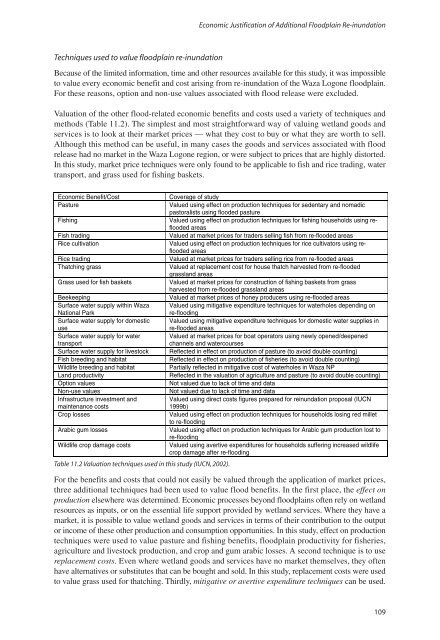The return of the water - IUCN
The return of the water - IUCN
The return of the water - IUCN
Create successful ePaper yourself
Turn your PDF publications into a flip-book with our unique Google optimized e-Paper software.
Economic Justification <strong>of</strong> Additional Floodplain Re-inundation<br />
Techniques used to value floodplain re-inundation<br />
Because <strong>of</strong> <strong>the</strong> limited information, time and o<strong>the</strong>r resources available for this study, it was impossible<br />
to value every economic benefit and cost arising from re-inundation <strong>of</strong> <strong>the</strong> Waza Logone floodplain.<br />
For <strong>the</strong>se reasons, option and non-use values associated with flood release were excluded.<br />
Valuation <strong>of</strong> <strong>the</strong> o<strong>the</strong>r flood-related economic benefits and costs used a variety <strong>of</strong> techniques and<br />
methods (Table 11.2). <strong>The</strong> simplest and most straightforward way <strong>of</strong> valuing wetland goods and<br />
services is to look at <strong>the</strong>ir market prices — what <strong>the</strong>y cost to buy or what <strong>the</strong>y are worth to sell.<br />
Although this method can be useful, in many cases <strong>the</strong> goods and services associated with flood<br />
release had no market in <strong>the</strong> Waza Logone region, or were subject to prices that are highly distorted.<br />
In this study, market price techniques were only found to be applicable to fish and rice trading, <strong>water</strong><br />
transport, and grass used for fishing baskets.<br />
Economic Benefit/Cost Coverage <strong>of</strong> study<br />
Pasture Valued using effect on production techniques for sedentary and nomadic<br />
pastoralists using flooded pasture<br />
Fishing Valued using effect on production techniques for fishing households using reflooded<br />
areas<br />
Fish trading Valued at market prices for traders selling fish from re-flooded areas<br />
Rice cultivation Valued using effect on production techniques for rice cultivators using reflooded<br />
areas<br />
Rice trading Valued at market prices for traders selling rice from re-flooded areas<br />
Thatching grass Valued at replacement cost for house thatch harvested from re-flooded<br />
grassland areas<br />
Grass used for fish baskets Valued at market prices for construction <strong>of</strong> fishing baskets from grass<br />
harvested from re-flooded grassland areas<br />
Beekeeping Valued at market prices <strong>of</strong> honey producers using re-flooded areas<br />
Surface <strong>water</strong> supply within Waza Valued using mitigative expenditure techniques for <strong>water</strong>holes depending on<br />
National Park<br />
re-flooding<br />
Surface <strong>water</strong> supply for domestic Valued using mitigative expenditure techniques for domestic <strong>water</strong> supplies in<br />
use<br />
re-flooded areas<br />
Surface <strong>water</strong> supply for <strong>water</strong> Valued at market prices for boat operators using newly opened/deepened<br />
transport<br />
channels and <strong>water</strong>courses<br />
Surface <strong>water</strong> supply for livestock Reflected in effect on production <strong>of</strong> pasture (to avoid double counting)<br />
Fish breeding and habitat Reflected in effect on production <strong>of</strong> fisheries (to avoid double counting)<br />
Wildlife breeding and habitat Partially reflected in mitigative cost <strong>of</strong> <strong>water</strong>holes in Waza NP<br />
Land productivity Reflected in <strong>the</strong> valuation <strong>of</strong> agriculture and pasture (to avoid double counting)<br />
Option values Not valued due to lack <strong>of</strong> time and data<br />
Non-use values Not valued due to lack <strong>of</strong> time and data<br />
Infrastructure investment and<br />
Valued using direct costs figures prepared for reinundation proposal (<strong>IUCN</strong><br />
maintenance costs<br />
1999b)<br />
Crop losses Valued using effect on production techniques for households losing red millet<br />
to re-flooding<br />
Arabic gum losses Valued using effect on production techniques for Arabic gum production lost to<br />
re-flooding<br />
Wildlife crop damage costs Valued using avertive expenditures for households suffering increased wildlife<br />
crop damage after re-flooding<br />
Table 11.2 Valuation techniques used in this study (<strong>IUCN</strong>, 2002).<br />
For <strong>the</strong> benefits and costs that could not easily be valued through <strong>the</strong> application <strong>of</strong> market prices,<br />
three additional techniques had been used to value flood benefits. In <strong>the</strong> first place, <strong>the</strong> effect on<br />
production elsewhere was determined. Economic processes beyond floodplains <strong>of</strong>ten rely on wetland<br />
resources as inputs, or on <strong>the</strong> essential life support provided by wetland services. Where <strong>the</strong>y have a<br />
market, it is possible to value wetland goods and services in terms <strong>of</strong> <strong>the</strong>ir contribution to <strong>the</strong> output<br />
or income <strong>of</strong> <strong>the</strong>se o<strong>the</strong>r production and consumption opportunities. In this study, effect on production<br />
techniques were used to value pasture and fishing benefits, floodplain productivity for fisheries,<br />
agriculture and livestock production, and crop and gum arabic losses. A second technique is to use<br />
replacement costs. Even where wetland goods and services have no market <strong>the</strong>mselves, <strong>the</strong>y <strong>of</strong>ten<br />
have alternatives or substitutes that can be bought and sold. In this study, replacement costs were used<br />
to value grass used for thatching. Thirdly, mitigative or avertive expenditure techniques can be used.<br />
109












